H-K Models Meteor F.4 EE549 flown by AVM Sir J.M. Robb
Meteor EE549:
The first major change in the Gloster Meteor came with the Meteor F.4, which went into production in 1946, after the first F.4 prototype flew on May 17, 1945. The major change with the F.4 was the use of Rolls-Royce Derwent 5 engines, which were a smaller version of the Nene. After a few had been produced, the wings were clipped shorter than the F.3 with blunter tips, derived from the world speed record prototypes. The aircraft featured a stronger airframe, fully pressurized cockpit, lighter ailerons to improve maneuverability, and rudder trim adjustments to reduce snaking. The F.4 was 100 mph faster than the F.3 at sea level (585 against 485), although the reduced-span wings impaired its rate of climb. The new Meteor had much better performance than earlier models, reaching 570mph at 10,000ft, which was 80mph faster than the F.3. Acceleration was also dramatically improved. The F.4 also had fully harmonized controls, making it much easier to fly.
Late in 1945, two F.3 Meteors were modified for an attempt on the world air speed record. On November 7, 1945, Group Captain Hugh "Willie" Wilson set the first official air speed record by a jet aircraft of 606 miles per hour at Herne Bay in Kent. In 1946, Group Captain Edward "Teddy" Donaldson broke this record with a speed of 616 mph in EE549, a Meteor F.4. that had been modified by removal of the cannon armament and strengthening of the canopy to deal with the higher speed. Test pilot Roland Beamont had previously taken the same aircraft to its compressibility limit at 632 mph, but not under official record conditions, and outside its official safety limits.
After early service in the First World War with the Northumberland Fusiliers, James M. Robb joined the Royal Flying Corps and became a flying ace credited with seven aerial victories by the end of the war. Granted a permanent commission in the Royal Air Force in 1919, he commanded 30 Squadron in the Iraqi revolt against the British in 1921.
In 1939, Group Captain Robb participated in the establishment of the Empire Air Training Scheme, a massive training program that provided the Royal Air Force with trained aircrew from Canada, Australia, New Zealand and Southern Rhodesia throughout the Second World War. In January 1940 he was promoted to Air Commodore and took command of 2 Group, Bomber Command in April. He held command of the unit, which operated the Bristol Blenheim, during the terrible battles on the Western Front in May 1940 which saw terrific losses in the Blenheim squadrons operating in daylight. He planned the attacks on the German invasion ports during the Battle of Britain. In January 1941, he fell out with the head of RAF Bomber Command, Air Marshal Sir Richard Peirse, over the merits of sending Blenheims on unescorted daylight missions against German channel shipping, which Robb regarded as suicidal. He was transferred to Coastal Command, where he commanded 15 Group, operating over the Bay of Biscay.
Robb became Deputy Chief of Combined Operations under Lord Louis Mountbatten in 1942. During Operation Torch he was air advisor to General Dwight Eisenhower; in February 1943, Eisenhower appointed him Deputy Commander of the Northwest African Air Forces. When Eisenhower became Supreme Allied Commander in Europe in January 1944, he brought Robb along as Deputy Chief of Staff (Air). Robb was promoted to Air Marshal in October 1944 and became Commander-in-Chief of Fighter Command in May 1945, where he learned to fly the Gloster Meteor. He became Vice-Chief of the Air Staff in 1947, and then Commander in Chief, Air Forces, Western Union Defence Organisation in 1948. In 1951 he became Inspector General of the RAF. By the time he retired for health reasons in 1952, he claimed to have flown over 150 different aircraft types in his career. After retiring from the RAF, he became King of Arms of the Order of the Bath on March 21, 1952, remaining in this appointment until January 1965. He died at a nursing home in Bognor Regis, Sussex on December 18, 1968.
During his time as CinC Fighter Command and in his later post-war posts, Robb was well-known for flying his Spitfire XVI, SL721, which had a special azure blue paint scheme. In late 1948, he discovered that EE549, the record-breaking Meteor, had been returned to semi-operational status though it was still unarmed. Exercising the privilege of his position, he then adopted the world's fastest jet airplane for his personal transport, painting and marking it as he had the Spitfire.
This model utilizes the new Fisher Models corrected resin intakes and Lifelike Decals 32-013 "Supermarine Spitfire Part 4" to adapt the personal markings of Spifire XVI SL721. Serials and national insignia came from various Xtradecal sheets.
Paul Fisher will release a resin conversion set to turn this kit into the Meteor F.8 in late February, with a F.3 conversion shortly after in March/April. He will also be doing T.7, N.F.11 and N.F.14 conversions over the rest of the year.
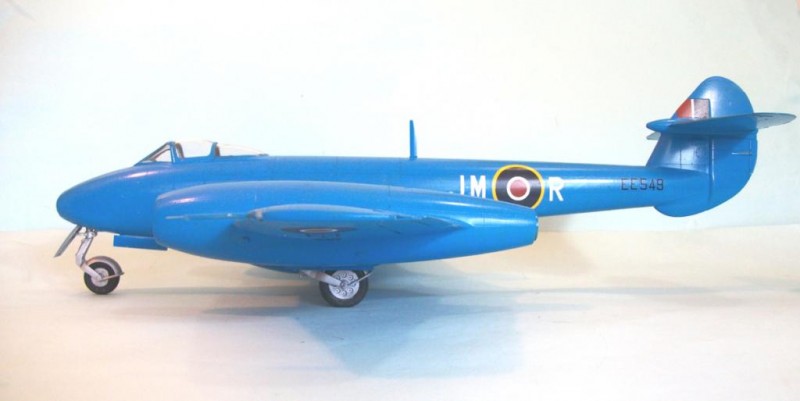
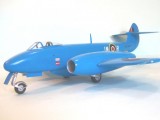
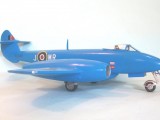
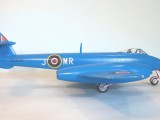
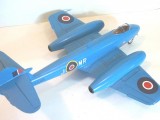
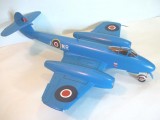
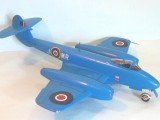
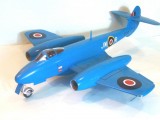

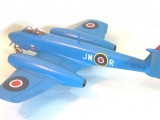
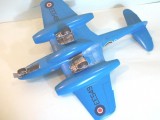
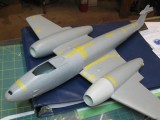
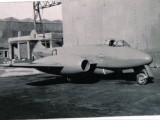
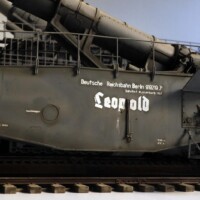
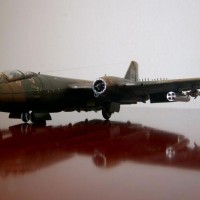
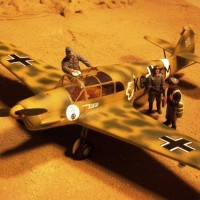
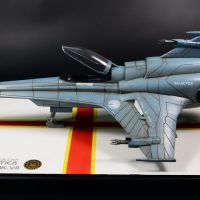
Another Cleaver Classic... with a great article and eye catching subject matter painted in Blue. Definitely off beat for a F.4 which makes it interesting of course. No Silver or RAF Grey or Green no it has to do be Blue.
Two thumbs up on this one TC.
I'm firing my editor, strike do from the last sentence.
It struck me that a color like this would give everyone a very serious view of how much the resin intakes improve the overall shape. Plus it's unlikely anyone else will do this. 🙂
Very striking aircraft Tom. Really appreciate the background info.
beautiful scheme...and the paint job looks flawless...bet that really livens up the old case
It does indeed.
Tom,
This a great looking model of a great looking airplane. I really like the story and the scheme.
Tom, this is really beautiful, does this mean the kit is now generally available?
Should be soon.
One of our older club members flew everything from Spitfires to Venoms. He said the Meteor was an airframe the Ministry would always choose to experiment on with every new-fangled idea - you never knew what it was going to look like from one week to the next (probably an exaggeration), but if you've seen the Mark with the extended forward fuselage, where the pilot lay on his front, prone, you'll get the drift.
Wow. That's BLUE! Tempting.
Tom, Wow, a 1/32 Meteor! Quite an interesting story behind this one, and what a nice color. Fantastic job as always from you, and many thanks for sharing this.
Thanks for the history of the Meteor. Now I know the difference between the F3 and F4 variants. Very nice model BTW.